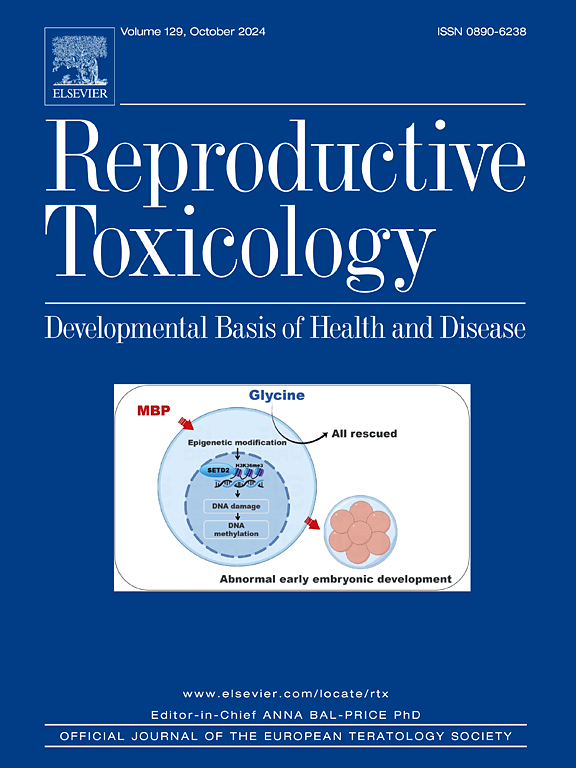Subchronic exposure to Voliam Targo® affects ovarian histology and reproductive performance in rabbits (Oryctolagus cuniculus).
IF 2.8
4区 医学
Q2 REPRODUCTIVE BIOLOGY
引用次数: 0
Abstract
In the current study, we evaluated the subchronic toxic effects of the Voliam Targo® (VT) insecticide on the ovaries of rabbits (Oryctolagus cuniculus) as well as the potential reproductive performance effects. The experiment was conducted using thirty females and thirty males, which were divided into two treated groups: control (distilled water) and VT (15 mg/kg b.w., by gavage, daily for 85 days). After a treatment period of 17 days, male and female rabbits from the two groups were randomly assigned to four artificial insemination (AI) mating groups using heterospermy or homospermy. The regimen continued through the gestation periods until 35 days of lactation, during which the first-generation (F1) offspring were monitored. At the end of the study, histomorphometric and immunohistochemical analyses were used to assess ovarian damage. The results revealed that body, ovary, uterine horn, cervix, and vagina weights did not vary significantly in the VT group compared to the control. Concerning reproductive performance, paternal exposure to VT insecticide caused a significant (p < 0.01) increase in the number of live fetuses and a decrease in the percentage of death in pups during the postnatal period. Also, VT treatment resulted in ovarian tissue structure disorganization, including follicular atresia, hemorrhagic follicles, and ovarian degeneration. Moreover, Ki67, P53, and Bcl-2 protein expression in the ovaries of the VT-treated group differed from the control group. This study suggests that subchronic exposure to Voliam Targo® may affect ovarian structure and reproductive performance by altering cell proliferation and apoptosis.
亚慢性暴露于Voliam Targo®会影响兔(Oryctolagus cuuniculus)卵巢组织学和生殖性能。
在本研究中,我们评估了Voliam Targo®(VT)杀虫剂对家兔(Oryctolagus cuniculus)卵巢的亚慢性毒性作用以及潜在的生殖性能影响。试验选用雌性30只,雄性30只,分为对照组(蒸馏水)和VT(15 mg/kg b.w,灌胃,每天85 d) 2个处理组。处理17 d后,将两组雌雄兔随机分为异精或同精4个人工授精(AI)交配组。该方案持续整个妊娠期,直到哺乳期35天,在此期间监测第一代(F1)后代。在研究结束时,使用组织形态学和免疫组织化学分析来评估卵巢损伤。结果显示,与对照组相比,VT组的身体、卵巢、子宫角、子宫颈和阴道重量没有明显变化。在繁殖性能方面,父方接触VT杀虫剂可显著(p <; 0.01)提高产仔数,降低产后幼崽死亡率。此外,VT治疗导致卵巢组织结构紊乱,包括卵泡闭锁、出血性卵泡和卵巢变性。此外,vt治疗组卵巢中Ki67、P53和Bcl-2蛋白的表达与对照组不同。本研究提示亚慢性暴露于Voliam Targo®可能通过改变细胞增殖和凋亡影响卵巢结构和生殖性能。
本文章由计算机程序翻译,如有差异,请以英文原文为准。
求助全文
约1分钟内获得全文
求助全文
来源期刊

Reproductive toxicology
生物-毒理学
CiteScore
6.50
自引率
3.00%
发文量
131
审稿时长
45 days
期刊介绍:
Drawing from a large number of disciplines, Reproductive Toxicology publishes timely, original research on the influence of chemical and physical agents on reproduction. Written by and for obstetricians, pediatricians, embryologists, teratologists, geneticists, toxicologists, andrologists, and others interested in detecting potential reproductive hazards, the journal is a forum for communication among researchers and practitioners. Articles focus on the application of in vitro, animal and clinical research to the practice of clinical medicine.
All aspects of reproduction are within the scope of Reproductive Toxicology, including the formation and maturation of male and female gametes, sexual function, the events surrounding the fusion of gametes and the development of the fertilized ovum, nourishment and transport of the conceptus within the genital tract, implantation, embryogenesis, intrauterine growth, placentation and placental function, parturition, lactation and neonatal survival. Adverse reproductive effects in males will be considered as significant as adverse effects occurring in females. To provide a balanced presentation of approaches, equal emphasis will be given to clinical and animal or in vitro work. Typical end points that will be studied by contributors include infertility, sexual dysfunction, spontaneous abortion, malformations, abnormal histogenesis, stillbirth, intrauterine growth retardation, prematurity, behavioral abnormalities, and perinatal mortality.
 求助内容:
求助内容: 应助结果提醒方式:
应助结果提醒方式:


